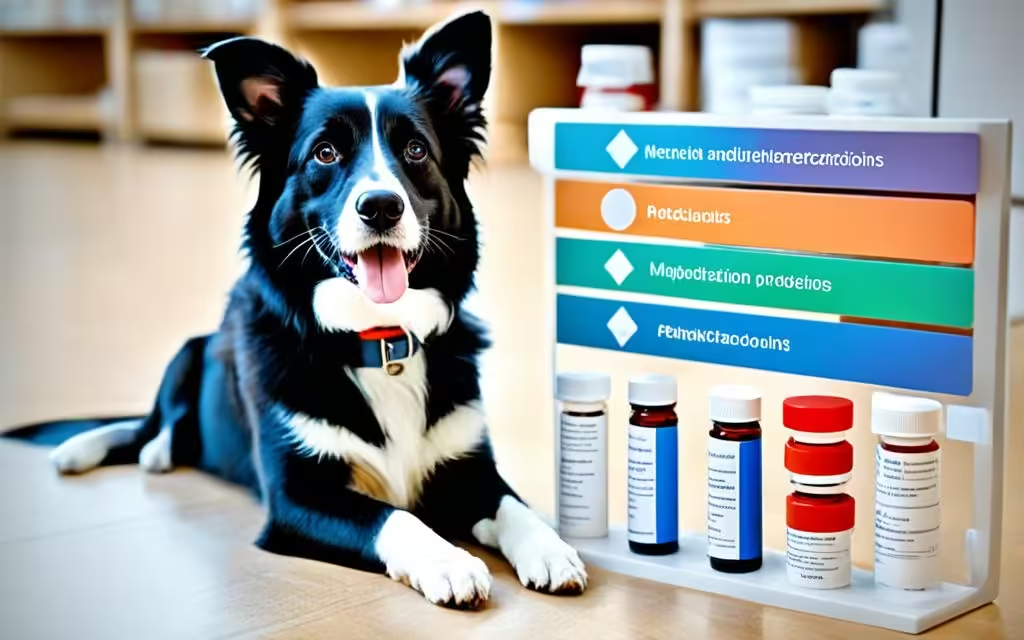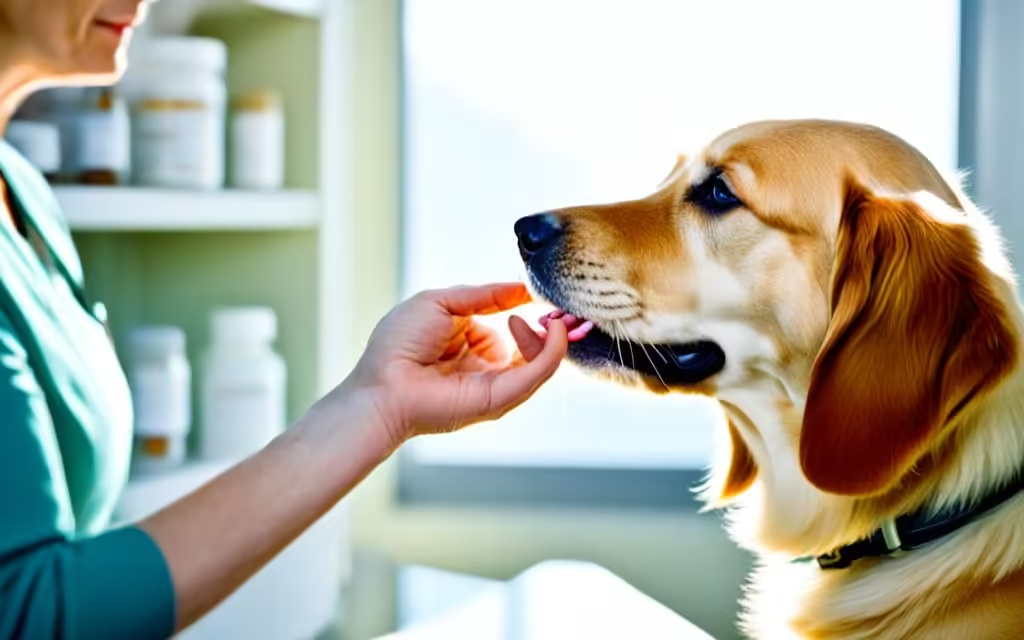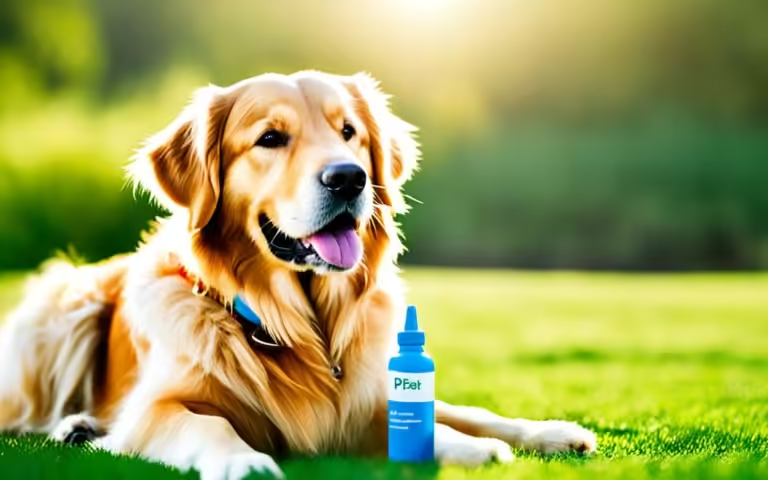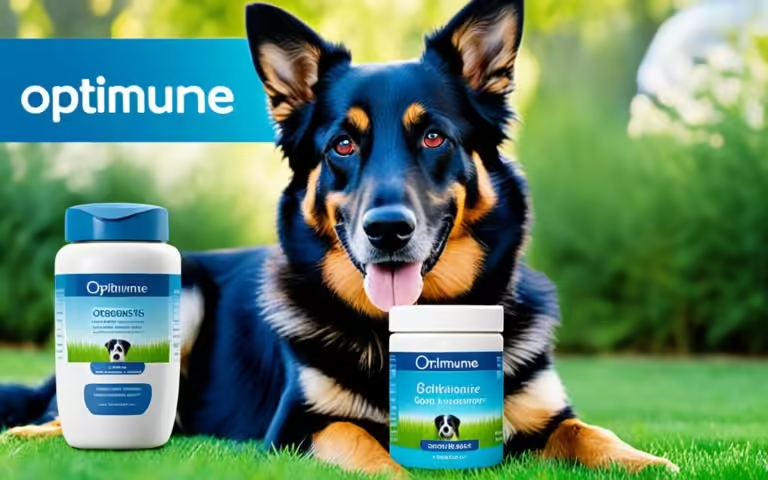Clindamycin for Dogs: Uses and Safety Information
Did you know that CLINTABS®, a popular clindamycin antibiotic for dogs, comes in three sizes? These sizes range from 25 mg to 150 mg1. This variety makes it easy for pet owners to find the right dose for their dogs, no matter their size. Clindamycin is a key antibiotic for treating many bacterial infections in dogs and cats. It’s vital for pet owners to know how to use it and its possible side effects.
Key Takeaways
- Clindamycin is an effective antibiotic used to treat a range of bacterial infections in dogs and cats.
- The medication is available in oral liquid, tablet, and capsule forms, with dosages tailored to the animal’s size.
- Common side effects of clindamycin include vomiting and diarrhea, but it should be used with caution in pets with kidney or liver disease.
- Clindamycin has both approved and “off-label” uses, such as treating toxoplasmosis, a protozoal infection.
- Proper dosage, administration, and precautions are crucial for the safe and effective use of clindamycin in canine patients.
Table of Contents
What is Clindamycin?
Clindamycin is a broad-spectrum lincosamide antibiotic. It works against many gram-positive aerobic bacteria, like Staphylococcus and Streptococcus. It also fights anaerobic bacteria and some protozoal infections, such as Toxoplasma234.
The FDA has approved it for dogs and cats with certain infections, like wounds and abscesses3. But, vets might use it for other infections too, like skin problems and dental infections24.
Understanding the Antibiotic
Clindamycin is the top choice for treating toxoplasmosis in dogs and cats3. It’s given in higher doses for toxoplasmosis than for bacterial infections3.
Signs of toxoplasmosis often get better in the first 48 hours3. But, some issues like muscle wasting and eye problems might take longer to heal3.
Approved Uses and Off-Label Applications
Clindamycin is also used off-label for infections like babesiosis and neosporosis in dogs and cats4. For mixed infections, it might be given with other antibiotics for better coverage3.
“Clindamycin is considered the treatment of choice for clinical Toxoplasmosis in both dogs and cats.”3
Administration Methods for Dogs
Clindamycin is a powerful antibiotic for dogs with bacterial and protozoal infections. It comes in easy-to-use forms like liquid, tablets, or capsules5.
Oral Liquid, Tablets, and Capsules
For dogs who can’t swallow pills, the oral liquid is a great choice6. You can mix it into their food or use a syringe. Tablets and capsules are also easy for some owners6.
Clindamycin tastes very bitter, so dogs might not want to take it. To make sure they get the whole dose, you can hide it in food or treats7.
Timing and Food Considerations
Clindamycin works fast in dogs, reaching effective levels in just 15 minutes6. You can give it with or without food, but never as a dry pill to avoid esophageal problems5.
It might take a few days to see the full effects. Keep giving the medicine as told, even if your dog seems better. This helps clear the infection and stops antibiotic resistance7.
“Administering antibiotics to cats can be more challenging compared to dogs due to their tendency to spit out bitter medication if detected in their food.”7
Clindamycin has many ways to give it to dogs, making it easy for owners to pick the best one. Giving it right is key to getting the best results and avoiding problems567.,,
Clindamycin for dog: Indications and Efficacy
Clindamycin is a key antibiotic in dog medicine, used for many bacterial infections8. It’s only by prescription and works fast, spreading through the dog’s body to stop bacteria from growing8.
Treating Bacterial Infections in Dogs
Clindamycin is great for treating many bacterial infections in dogs, like skin infections, wounds, and dental problems8. Research shows it works well against many bacteria, helping 80% to 90% of dogs with skin infections9. All dogs with serious skin infections got better with this treatment9.
Combating Protozoal Infections Like Toxoplasmosis
Clindamycin is also top choice for treating toxoplasmosis in dogs and cats8. It’s given in higher doses for this infection. Signs of improvement can be seen in the first two days, but some issues might take longer to heal.
Severe allergic reactions to clindamycin are rare in dogs8. But, dogs with liver or kidney problems need careful dosing8. It’s wise to check their blood work often if they’re on this medicine for a long time810.
“Clindamycin was found to be an effective, safe, and convenient antibiotic for treating deep staphylococcal pyoderma in dogs.”9
In short, clindamycin is a powerful medicine for dogs, fighting many infections safely and effectively when used correctly.
Potential Side Effects and Precautions
Clindamycin is usually safe for dogs when given as directed. But, it can sometimes cause side effects. Common issues include vomiting and diarrhea11. These problems might happen because the antibiotic can upset the stomach11. In some cases, dogs may have bloody diarrhea12.
Clindamycin can also irritate the esophagus, leading to esophagitis and esophageal stricture11. To lower this risk, give clindamycin with food11. Some dogs may drool a lot, known as hypersalivation11.
Injectable clindamycin might cause pain at the injection site13. Watch your dog for any bad reactions and call the vet if you see anything worrying12.

There are precautions to take when giving clindamycin to dogs. Dogs with severe kidney or liver issues might need a smaller dose13. The drug can also cross the placenta and get into milk, so be careful with pregnant or nursing dogs13.
Clindamycin can sometimes cause a serious gut problem from Clostridioides difficile bacteria12. Look out for signs like ongoing diarrhea, belly pain, and fever12.
Knowing about the possible side effects and being cautious helps pet owners use clindamycin safely. This way, dogs can get the treatment they need with fewer risks111312.
Dosage and Missed Dose Guidelines
Administering clindamycin to dogs depends on their weight. Common forms include 25 mg, 75 mg, 150 mg, and 300 mg capsules, and 25 mg, 75 mg, and 150 mg tablets14. Dogs usually get 5 mg per pound every 12 hours, or 10 mg per pound every 24 hours15.
It’s vital to follow the dosing instructions closely. If you miss a dose, give it when you remember, but skip it if it’s near the next dose16. Never give a double dose to make up for a missed one, as it can be harmful16.
You can give clindamycin with or without food, but getting the dose right is key. Liquid forms need careful measurement, and some pets may require special help14. If your pet misses a dose, see a vet for advice on what to do next16.
Following the right dosage and schedule is key for clindamycin to work well and keep your dog safe. If you’re unsure about giving clindamycin to your dog, talk to a vet.
Drug Interactions and Monitoring
When giving clindamycin to dogs, knowing about possible drug interactions is key. It’s important to watch the pet’s health closely. Clindamycin might change how other medicines work, making them more or less effective17. It’s vital to keep an eye on the pet when using clindamycin, especially if they’re on other drugs or treatments for a long time18.
Medications to Avoid Combining
Don’t mix clindamycin with erythromycin because they might cancel each other out17. It could also make some muscle relaxants work too well and lower the levels of cyclosporine17. Using clindamycin with certain antidepressants can lead to serotonin syndrome, a serious condition17.
Liver and Kidney Function Tests
If a dog is on clindamycin for over 30 days, the vet might check liver and kidney functions17. This is because clindamycin goes through the liver and is passed out by the kidneys. Long-term use could affect these organs19. Keeping a close watch is crucial, as while rare, drug interactions can happen, especially with medicines that are closely balanced or processed in a single way18.

In short, pet owners should tell their vets about all the meds, supplements, and foods their dogs take. This helps ensure clindamycin is used safely and avoids bad drug reactions171918.
Storage and Handling
Storing and handling clindamycin correctly is key to its effectiveness and safety for your dog20. This medication, known by names like Antirobe, Clinacin, and Clindabactin, should stay cool, below 25°C, and not in the fridge20. Keep it in an airtight container away from sunlight to keep it potent21.
If your vet made a special clindamycin for your pet, follow the storage and expiration directions on the label21. This keeps the oral solution from getting thick, keeping it ready to use21.
By storing it right, you keep the antibiotic working well and your dog gets the help it needs20. Also, don’t let it get too hot or sit in the sun to keep it effective20.
Remember, how you store and handle clindamycin is key to your dog’s health during treatment20. If you’re unsure, talk to your vet about the best way to store and handle this important antibiotic20.
Emergency Situations and Overdose
Clindamycin is usually safe for dogs, but knowing what to do in emergencies is key22. If a pet shows signs of an overdose or bad reaction, call the vet right away22. If the vet is not reachable, know who to call for help22.
Clindamycin overdoses in dogs are rare but serious23. They can cause vomiting, diarrhea, or even seizures23. Quick vet care is vital to prevent worse problems22.
There’s not much known about clindamycin overdoses in dogs22. But early tests show it’s safe22. Still, owners should watch for bad reactions and get help fast if needed.
If an emergency happens, tell the vet about your dog’s health history and any meds they’re on24. This info helps the vet give the best care.
Being informed helps keep dogs safe with clindamycin and other meds22. Quick action and talking to vets can help in emergencies222324.
Clindamycin vs. Other Antibiotics
Vets have many antibiotics to choose from when treating dog infections. Clindamycin is one option, but it’s good to compare it with others. This includes looking at how well they work, their cost, and their side effects25.
Comparing Efficacy, Cost, and Side Effects
Clindamycin works against many types of infections in dogs, like skin and dental infections25. It’s often used with other antibiotics to fight off gram-negative bacteria25.
Clindamycin is a generic drug, so it’s cheaper than some other antibiotics25. The cost depends on the strength and how long the dog needs it.
Clindamycin can cause stomach issues and irritation in dogs25. Vets might watch the dog’s liver and kidneys closely, especially if they have health problems25.
Clindamycin is good at fighting certain infections, but the best choice depends on the dog and the infection25. The vet will decide based on the situation.
Choosing the right antibiotic should always involve a vet’s advice252627. They consider the dog’s health, the infection type, and any possible drug issues.
Essential Drug Information Summary
Clindamycin is a broad-spectrum antibiotic used to treat various infections in dogs28. It works against bacteria and protozoa, including some staphylococci, toxoplasmosis, and Babesia spp28. This antibiotic stops bacteria from growing by blocking their protein synthesis28.
This drug is FDA-approved for dogs and cats, but some uses are off-label28. It’s great for treating infections in the skin, lungs, and bones28. Clindamycin is especially useful for infections like lung abscesses and bone infections28.
Clindamycin comes in liquid, tablets, and capsules and can be given with or without food29. Dogs usually get 2.5 to 15 mg per pound of body weight every 12 hours29. The dose depends on how severe the infection is29.
Side effects include stomach issues, loss of appetite, and allergic reactions29. It’s important to watch the dog closely and not give them too much of the medicine29.
Clindamycin can interact with other drugs, like those affecting muscle signals29. It’s important to check liver and kidney function during long-term use29.
It’s key to store clindamycin correctly, at room temperature between 68-77°F29. Treatment can last from a week for simple infections to four weeks for more severe ones29.
In dogs with pacemaker infections, clindamycin has been successful in treating Staphylococcus aureus infections30. This shows how effective clindamycin can be in treating different infections in dogs30.
| Key Information | Summary |
|---|---|
| Common Names | Clindamycin |
| Drug Type | Lincosamide Antibiotic |
| Uses | Treat bacterial and protozoal infections in dogs, including skin, soft tissue, respiratory, and bone infections |
| Administration | Oral liquid, tablets, or capsules, with or without food |
| FDA Approval | Approved for use in dogs and cats, some off-label applications |
| Mode of Action | Inhibits protein synthesis in susceptible bacteria, leading to growth inhibition |
| Benefits | Effective against a variety of bacterial and protozoal infections, particularly anaerobic infections |
| Side Effects | Gastrointestinal upset, loss of appetite, allergic reactions, anemia, liver enzyme changes, blood disorders, severe intestinal inflammation |
| Precautions | Use with caution in pets with liver or kidney dysfunction, not for small pets like guinea pigs, hamsters, and rabbits |
| Drug Interactions | Interacts with medications that block neuromuscular signals, such as pancuronium, cyclosporine, and erythromycin |
| Monitoring | Liver and kidney function tests may be necessary with long-term use |
| Storage | Commercial liquid and tablet forms should be stored at room temperature between 68-77°F |
| Emergency Situations | Overdosing can lead to serious complications, so it’s crucial not to double up on doses |
“In a specific case study, a 13.5-year-old dog with a pacemaker infection was successfully treated with a 4-week course of oral clindamycin after other antibiotic regimens failed to clear the Staphylococcus aureus infection without requiring explantation of the device.”30
Conclusion
Clindamycin is a versatile antibiotic for dogs, treating many bacterial and protozoal infections. It should be used with a vet’s guidance31. Pet owners need to know how to use it, its side effects, and safety tips. This helps them work with vets for the best care for their dogs.
This article highlights the key points of using clindamycin. It stresses the need for careful monitoring and following up with the vet3233. It also talks about antibiotic resistance and its effect on the environment. By staying informed and working with vets, pet owners can use clindamycin wisely. This keeps their dogs healthy and reduces antibiotic risks.
As pet owners, it’s crucial to keep track of important info and practice responsible pet care. Using clindamycin or any medication wisely helps keep dogs healthy. It also supports the development of safe and effective treatments for the future.
FAQ
What is clindamycin and how is it used for dogs?
What are the approved and off-label uses of clindamycin in dogs?
How should clindamycin be administered to dogs?
What types of bacterial and protozoal infections can clindamycin treat in dogs?
What are the potential side effects of clindamycin in dogs?
What is the proper dosage of clindamycin for dogs?
Can clindamycin interact with other medications?
How should clindamycin be stored?
What should I do if I suspect an overdose or adverse reaction to clindamycin?
How does clindamycin compare to other antibiotics for dogs?
Source Links
- CLINTABS® (clindamycin hydrochloride) Tablets
- Clindamycin | VCA Animal Hospitals
- Uses, Dosage & Side Effects
- Clindamycin
- Clindamycin
- NvClindamycin Capsules (150 mg) for Dogs (Canada) – Drugs.com
- How to Administer Prescription Antibiotics to Pets
- Clindamycin For Dogs
- Clindamycin Hydrochloride (Clindadrops, Antirobe, Cleosin)
- Clindamycin for Dogs
- Clindamycin HCl Oral: Uses, Side Effects, Interactions, Pictures, Warnings & Dosing – WebMD
- Clindamycin for Dogs and Cats
- Clindamycin [Companion]
- Does Missing a Dose of Your Pet’s Medication Put Them at Risk?
- Dangerous Pet Medication Mixes to Avoid
- Drug interactions: expecting the unexpected! (Proceedings)
- Clindamycin Interactions Checker – Drugs.com
- Clindamycin in Vet Medicine – Facts and Information | PetCoach
- Clindamycin Uses, Dosage & Side Effects – Drugs.com
- What you Should Know if Your Dog is on Antibiotics
- CLINDAMYCIN HYDROCHLORIDE – Mar Vista Animal Medical Center
- A Guide to the Top Antibiotics for Dogs – Whole Dog Journal
- Doxycycline vs. clindamycin
- Treating Resistant Skin Infections in Dogs
- Clindamycin – an overview | ScienceDirect Topics
- Clindamycin for Dogs: Uses, Dosage, & Side Effects
- Successful Clindamycin Therapy of an Infected Subcutaneous Permanent Pacing Lead in a Dog after a Failed Course with Potentiated Amoxicillin and Enrofloxacin
- Metabolism of Clindamycin I: Absorption and Excretion of Clindamycin in Rat and Dog







